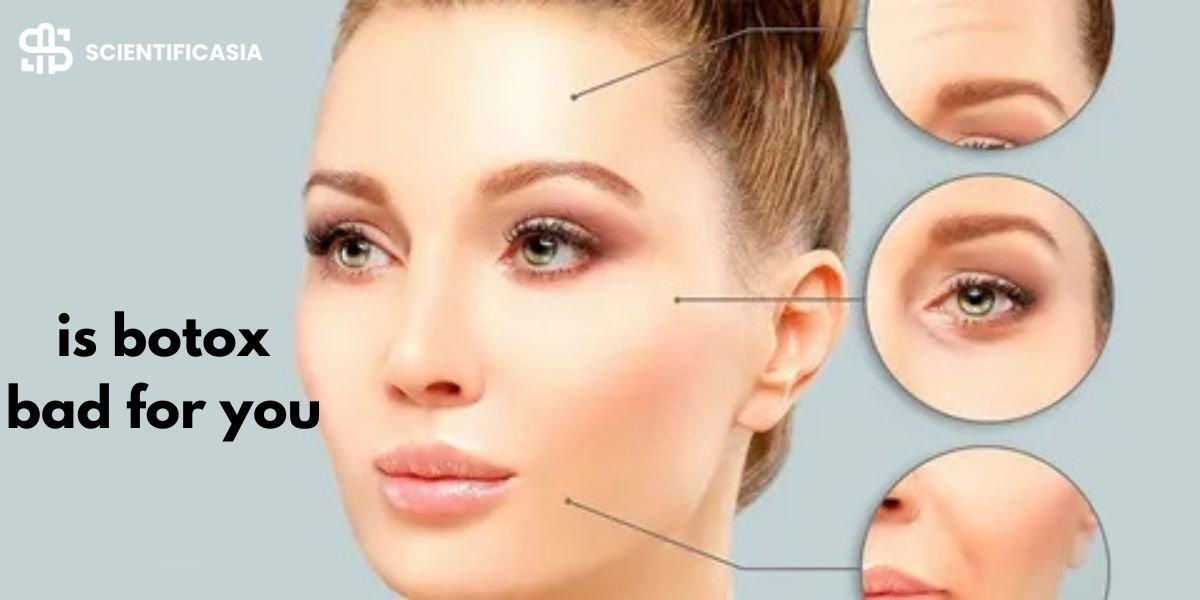Is botox bad for you? What does botox do to your face? Botox is the world’s most popular cosmetic surgery, having been licensed for cosmetic use more than 20 years ago, yet there are still many misunderstandings about this anti-wrinkle therapy. It can be challenging to determine whether Botox, despite its growing popularity, poses any potential health risks. When this treatment came out, it significantly changed the anti-aging industry. You may get rid of deep wrinkles and fine lines for a smoother, younger-looking face by only enduring a few small pinpricks.
We all know that Botox and other neuromodulators have excellent short-term benefits, but have you ever wondered about long term effects of Botox? In this article, we’ll discuss the possible risks and long-term positive and negative Botox side effects, as explained by healthcare professionals.
What Botox is made of?
What Botox is made of could help understand your query of whether “is Botox bad for you? or is Botox safe?”. A bacterium known as Clostridium botulinum toxin produces the neurotoxins used in Botox. Healthcare professionals use a specific type of bacteria (type A) for treatment injections.
Natural sources of botulinum toxins include contaminated foods and soil. Botulism can occur if you consume a lot of botulinum toxins or if the bacteria enter a wound. This serious problem with the nervous system makes it challenging to breathe. A laboratory manufactures Botox to ensure maximum safety and effectiveness. To prevent botulism, technicians sterilize and dilute the botulinum toxins.
How many units of Botox for lip flip?
How Much is Botox? A Detailed Cost Analysis
Is botox bad for you? What’s the Real Story?
Botox treatments use a small amount of botulinum toxin. Larger doses of this toxin can be harmful, but several studies have found that its use for cosmetic purposes is safe.
Adverse effects from cosmetics Botox is extremely rare and often associated with underlying conditions. It’s important to be healthy and not pregnant or breastfeeding before getting cosmetic treatments.
Getting Botox from a certified physician is crucial to receiving the safest and finest treatment possible. Additionally, ensure the injections meet FDA standards and the provider has experience with the procedure you want.
Note: In 24 years, only 36 cases of bad effects from Botox used for cosmetic reasons were recorded. An underlying illness may have caused more than half of these cases.
How You Prepare
What kind of botulinum toxin treatment is best for you depends on your condition and what you need. You should discuss with your doctor to determine whether is Botox bad for you, to ensure the best treatment.
If you have received any kind of Botox injection in the last four months, let your doctor know. Additionally, let your doctor know if you use blood thinners. To lower the chance of bleeding or bruises, you should stop taking them a few days before the injection. As soon as you can, make an appointment with the doctor who is prescribing these medications.
Eyebrow Lift Botox: Results You’ll Love
Botox 101: What to Know About Botox Before and After Your Treatment
What can you expect from a Botox treatment?
Before the procedure
Does Botox hurt? During the Botox treatment, individuals typically experience little or no pain. You may want your skin numbed first if you’re treating excessive foot or palm sweating. To numb the region, your healthcare professional may apply an anesthetic to the skin, use ice, or massage the area. The technique of massage is also known as vibration anesthesia.
During the procedure
A medical professional’s clinic typically performs cosmetic injectables like Botox. Your doctor injects small doses of botulinum toxin into your muscles or skin using a fine needle. The treatment area’s size and other factors determine how many injections are required. For some procedures, ultrasound helps the needle find the right spot.
There are two types of botulinum toxin:
- Type A. The primary purpose of type A is to cure wrinkles on the face. Type A injections include abobotulinumtoxinA (Dysport), onabotulinumtoxinA (Botox), incobotulinumtoxinA (Xeomin), daxibotulinumtoxinA (Daxxify), and prabotulinumtoxinA (Jeuveau).
- Type B. When treating neck spasms, Type B injection can often be the first choice. The popular type B injection name is rimabotulinumtoxinB (Myobloc).
After the procedure
After the treatment, don’t rub or touch the area for at least 24 hours. Additionally, avoid lying down for 4-6 hours after the injections. Following this guidance prevents the toxins from spreading to unwanted areas. Proper Botox aftercare ensures the best botox long-term effects, and you should be able to go back to your normal routines right away after the treatment, but first, talk to your doctor to be sure.
Results
Botox shots usually start to work one to three days after the procedure, but it may take a week or more to see the full effects. Not everyone sees clear results or gets better from their conditions.
Depending on the problem under treatment, the effects can persist for three to four months. To keep the effect going, you’ll probably need to get follow-up shots at least every three months.
Is Botox Bad for You Long-Term?
Because Botox only temporarily paralyzes muscles, there is a chance that it might weaken them over time, which could cause unexpected changes in facial structure or muscle function. Furthermore, the long-term effects of Botox use remain poorly understood, potentially leading to unknown or unstudied effects. There is evidence that it lowers blood flow and makes muscles weaker.
It’s vital to keep in mind that every person reacts differently to Botox, and not everyone will have the same results or side effects. This can be confusing because Botox can both prevent and trigger migraines.
Long-Term Effects of Botox
There have been questions raised concerning whether Is botox bad for you and the potential long-term effects. To be clear, Botox does not make skin healthier in any way. Furthermore, Botox is not a suitable option for treating wrinkles caused by muscular stress.
- Muscle Atrophy: Over time, prolonged Botox therapy may cause the treated areas’ muscles to weaken and atrophy. Botox injections have proven to reduce overall blood flow in the face.
- Self-cleansing Skin State: Our skin normally functions in the “self-cleansing skin state” until factors such as dryness, inflammation, imbalanced oil production, anxiety from acne treatments, and anti-aging protocols impact it.
- Resistance or Reduced Efficacy: After using Botox repeatedly, some people may become less sensitive to its effects, which means they need higher and higher doses of Botox.
- Migration: Rarely, Botox may spread to unexpected places, leading to cosmetic problems or unexpected muscular weakening.
- Numbness or Reduced Sensation: Extended Botox usage may cause treated regions to become numb or less sensitive.
- Changes in Skin Texture: Long-term muscle paralysis and constant bursts of significant inflammation at the start of each injection could cause changes in skin texture, which might affect natural expressions and skin flexibility.
- Dependency: Individuals who frequently use Botox injections may develop a psychological dependence on them to maintain their ideal appearance.
- Toxin Spread: Although it is generally believed to be extremely rare, the toxin may spread from the injection site to other parts of the body.
- Immunity Response: Sometimes, the body’s immune system might react badly to Botox, which could cause problems.
- Unknown Long-Term Effects: Due to the lack of long-term studies, prolonged Botox treatments may have unknown or unexpected adverse effects.
Can I Drink Alcohol After Botox? A Guide to Safe Recovery
DAO Botox (Depressor Anguli Oris Muscle)
The Age Factor in Botox
In the world of Botox treatments, age has a big impact on how and when people think about this aesthetic choice. When thinking about, Is botox bad for you especially the long term effects of Botox, it is important to consider the age aspect. Here is a summary of this crucial aspect:
- Botox for Younger People: People in their 20s and 30s may use Botox as a preventative measure to delay the appearance of wrinkles and fine lines. This is frequently called “preventative Botox.”
- Middle Age and Botox: As fine lines and wrinkles become more noticeable in their 40s and 50s, many people start using Botox. It can reduce the visibility of wrinkles that are already present.
- Botox for Older Persons: For older persons who want to treat their signs of aging, Botox may be beneficial. It can make a slight improvement, but it might not totally remove deeply etched creases.
- Long-term Use Across Ages: Although the frequency of Botox treatments may change with age, people of all ages should think about long-term use because of the temporary nature of the procedure.
- Professional Consultation: Before making any decisions about Botox, consult a skilled practitioner who can assess each patient’s needs and recommend the best course of action based on age and cosmetic objectives.
When thinking about the Botox long term effects, age is an important consideration. Age might affect the frequency and timing of treatments, so it’s critical to match your objectives and expectations with your specific stage of life.
The Risks of Overdoing Botox
Why is Botox bad for you? What does Botox do to your face? Although Botox can be quite helpful in reducing forehead wrinkles, using too much of it might have negative Botox side effects. Here is a summary of the main issues surrounding the dangers of using Botox too frequently:
- Risk of Unnatural Appearance: Overuse of Botox can result in a frozen, unnatural appearance with extremely restricted facial expressions.
- Risk of Unwanted Results: Getting too many Botox shots can cause unwanted effects like sagging eyes, uneven features, or an artificial look.
- Side Effects: Using more increases the risk of Botox side effects such as pain, redness, or swelling at the injection site.
- Balancing Natural Beauty: It’s important to find a balance between looking refreshed and keeping your natural facial expressions.
Is Botox bad for you long term? Botox side effects might last for a long time. However, if you have a trustworthy healthcare professional with you, this is quite unlikely to happen.
Who shouldn’t get Botox?
Before getting Botox, it’s important to consult your doctor or specialist to address the concern: Is Botox bad for your health? Not everyone is a suitable candidate. People with specific neuromuscular illnesses like myasthenia gravis or Eaton-Lambert syndrome, which affect the neuromuscular junctions, should not receive Botox injections. Therefore, Botox can worsen issues related to muscular weakness. Avoid using Botox if you have:
- Are you allergic to any of the components?
- Heart-related conditions
- Diabetic seizures
- Bleeding problems
- Glaucoma or recent eye surgery
- An active respiratory infection
- Conditions affecting the muscles or nerves
- Conditions like asthma or emphysema can cause breathing difficulties.
- Additional recent treatments have utilized botulinum toxin.
We do not recommend getting Botox while breastfeeding. Despite some studies suggesting its safety, insufficient research has determined whether breastfeeding transfers botulinum toxin to the baby. Similarly, doctors strongly advise against Botox during pregnancy due to the lack of clear evidence about potential risks to the fetus. As an alternative to Botox, doctors suggest certain chemical peels to help minimize fine wrinkles.
Note: Botox is safe and useful for many purposes when used in small dosages. Before scheduling an appointment, consult your dermatologist to ensure is Botox safe.
Can Botox Cause Cancer? Unveiling the Facts About Botox Safety
Masseter Botox: Procedure, Benefits, Risks & Cost Explained
Alternatives to BOTOX
Not only does BOTOX serve as a neuromodulator for reducing wrinkles and fine lines. Apart from BOTOX, Dysport, XEOMIN, and DAXXIFY provide exceptional wrinkle reduction results. The main purpose of neuromodulators is to relax the muscles that cause wrinkles, including expression lines like frown lines and crow’s feet. If you’re concerned, the most recent option currently on the market, DAXXIFY, is an amazing new choice since it produces benefits that last for months longer than those of BOTOX and the other options.
Takeaway
If you’re thinking about getting Botox injections or are worried about whether Is Botox bad for you?, you should only work with a certified and experienced medical professional.
Although cheaper or more comfortable, using an unlicensed person may increase your risk of problems. Keep in mind that the toxins last for three to six months, and you will probably need to come back for more treatments.
Side effects are ideal with every surgery. Consult your doctor about the injection and recovery process. They can discuss the pros and cons for you and answer questions regarding botox long term effects.
Reference:
Dr. Renita Ahluwalia | Toronto Dermatologist














